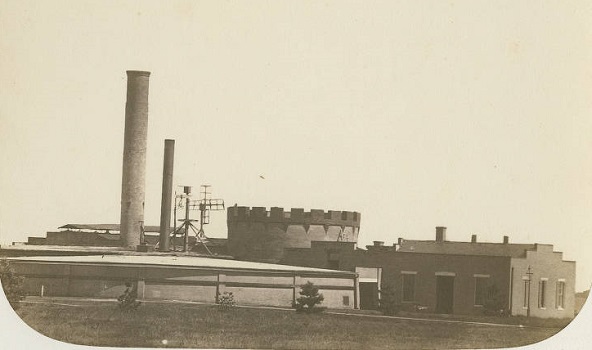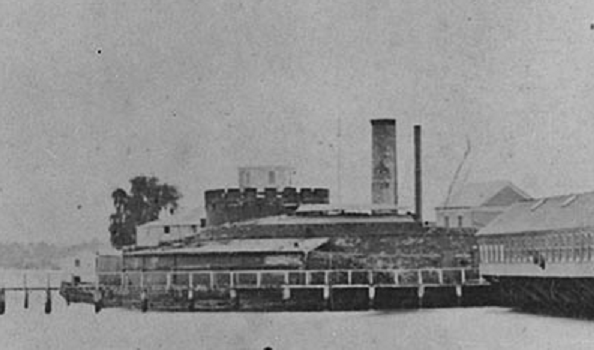

|
Chronological List of District Heating
Systems in the United States |
 |
 |
| Naval Academy Gas and Steam Plant in 1860-from Digital Maryland | Gas and Steam Plant in the late 1860s from Naval Historical Center |
Cornelius K. Stribling became superintendent of the U.S. Naval Academy at Annapolis on July 1, 1850, shortly after its new name had been adopted. Stribling undertook to reorganize the school and improve the physical plant. One of his improvements was to request funding for a plant to produce gas and hot water to heat and light the academy's buildings, which was approved by Congress in 1852. At the time hot water heating was virtually unknown in this country, but Stribling may have been familiar with or at least aware of the hot water system built by Thomas Winans for his Alexandroffsky estate in Baltimore, which used natural circulation to heat its twenty buildings. The academy's campus covered a fairly large area with more growth anticipated, and establishing the elevations required to a large natural circulation system would have been very challenging, if not impossible. A conversion to steam was made and the plant was supplying light and heat by late 1853.
Although congressional budget documents contain multiple references to the gas and steam plant over time, only a few brief mentions appear in Baltimore papers (no Annapolis papers from 1853 are known to exist). An 1872 history of Annapolis includes a brief mention of gas and steam being introduced in 1853, but the first known mention in engineering journals appearing in a British journal in 1888, with a second in 1892.
When Lockport inventor Birdsill Holly announced his introduction of commercial district steam heating in 1877 he mentioned that many earlier systems had existed, but did not mention any of them.
The academy apparently hired mechanics and laborers to install the system in 1853 rather than engaging a contractor. The U.S. Navy had substantial steam experience by this time.
The academy installed a high-temperature hot water system that began operation in June 1969.
References
1852 Report
of the Secretary of the Navy, December 4, 1852, H. Doc. 1,
32nd Congress, 2nd Session, Part 2, Volume 1
Page 446: The proposed mode of heating the buildings at the Naval
Academy with hot water, and of lighting the Observatory with gas, are
recommended by their superior safety and eventual economy.
1853 "Affairs
at the State Capital," The Baltimore Sun, December 6, 1853,
Page 4.
The church at the Naval Academy is approaching completion. The rooms are
now heated and lighted from the gas-house. It is proposed to erect a
laundry and ether convenient "fixens" for the academy.
1854 "Affairs
at the State Capital," The Baltimore Sun," January 3, 1854,
Page 1
We give below a list of the buildings erected at the U.S. Naval Academy
for the year 1853: A gas-house, (on the margin of the grounds;)
recitation hall for the corps of cadets; mess saloon; two Professors'
quarters; a church; and sea-wall environing the grounds. The church
is to be heated from the gas-house, which now furnishes the recitation
hall and cadets quarters through pipes, a distance of 800 feet.
Consequent upon the scarcity of work and the lateness of the season, it
has been deemed proper to dispense with 30 mechanics and 25 laborers.
1872 The
History of Annapolis, the Capital of Maryland: The State House, Its
Various Public Buildings ... Together with a Full History and
Description of the United States Naval Academy from Its Origin to the
Present Time, by Owen M. Taylor
Page 33: Gas and steam for heating were introduced in 1853, the
works for the same being built at an original cost of $28,044.28, and
certain additions afterwards made at a cost of $8,500.00.
1889 "The
District Distribution of Steam in the United States," by Charles
Edward Emery, Minutes of Proceedings of the Institution of Civil
Engineers 97:196-290 (March 1889)
Page 196: As early as 1853, steam was distributed from a central
station through cast-iron pipes, to various separate buildings of the
United States Naval Academy at Annapolis, Maryland. The system was
reconstructed with wrought-iron pipe, and extended in the years 1865 to
1868. The pipes were laid in connection with the gas and water-pipes in
small covered conduits, by the most direct routes, indiscriminately under
walks and greensward, the outlets being taken off through common tees.
Stuffing-boxes were applied in the longer lengths, and to prevent the
sleeves of the same from being blown out, clamps were placed on the pipes
with distance bolts; these frequently went to the extreme limit, so that
expansion was provided for at some points by the bending of the pipes in
the conduits, in which there was plenty of room. Such an aggregation of
parts was evidently not adapted for general use.
1892 "Transmission
of Power to a Distance," by Thomas Ludwick Miller, Journal of
the Liverpool Polytechnic Society 55:41-64 (1892)
Page 57: As early as 1853 steam was distributed from a central station
through cast iron pipes to various separate buildings of the United States
Naval Academy at Annapolis, Maryland. This plant, however, was used
more for heating purposes than for power supply.
1995 The Evolution of Heat, Light, and Power Systems at the U.S. Naval Academy: 1845-1995, by Morris A. Pierce, Presented at the Twelfth Naval History Symposium, 26-27 October 1995.
© 2024 Morris A. Pierce
Si